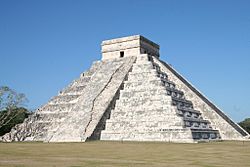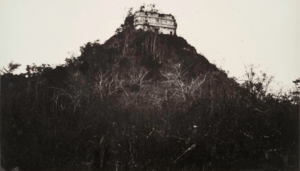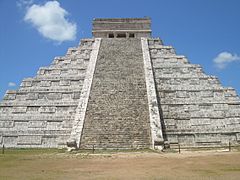El Castillo, Chichen Itza facts for kids
Quick facts for kids La Pirámide, Chichen Itza |
|
|---|---|

Temple of Kukulcán
|
|
| Ancient name | Kukulcan |
| Constructed | 8th–12th century AD |
| Type | Mesoamerican Step pyramid |
| Material | limestone |
| Height | 24 m (79 ft), without temple 30 m (98 ft), with temple 6 m (20 ft), Temple itself |
| Base | 55.3 m (181 ft) |
| Slope | 37°29'44" (edges) 47º19'50" (sides) |
| UNESCO World Heritage Site | |
| Location | Tinum Municipality, Mexico |
| Part of | Pre-Hispanic City of Chichen-Itza |
| Criteria | Cultural: (i), (ii), (iii) |
| Inscription | 1988 (12th Session) |
The Temple of Kukulcán, also known as La Pirámide, is a huge step-pyramid in the middle of the Chichen Itza archaeological site. Chichen Itza is located in the Yucatán state of Mexico. Archaeologists sometimes call this building Chichen Itza Structure 5B18.
The ancient Maya people built this pyramid between the 8th and 12th centuries AD. It was a temple for their god Kukulcán, who was a Feathered Serpent deity. This god was similar to Quetzalcoatl, a god known by the Aztecs. There's an older pyramid hidden inside this one, built for the same purpose many years before.
The pyramid has square levels, like giant steps, with stairways going up all four sides to a temple at the very top. Along the northern stairway, you can see sculptures of feathered serpents. During the spring and autumn equinoxes, something amazing happens! In the late afternoon, the sun creates shadows that look like a feathered serpent "crawling" down the pyramid's side. Thousands of people visit to see this special event.
Scientists have also found that if you clap your hands near the pyramid, it makes a sound like a quetzal bird chirping. Researchers believe the Maya builders designed the pyramid this way on purpose. The sound bounces off the pyramid's narrow limestone steps, making the unique bird-like echo.
Each of the pyramid's four sides has about 91 steps. If you add them all up and count the temple platform as the last step, you get 365 steps. This number matches the days in the Haab' year, which was an important calendar for the Maya. This connection likely played a role in their religious ceremonies.
The pyramid stands about 24 m (79 ft) tall. The temple on top adds another 6 m (20 ft) to its height. The square base of the pyramid measures 55.3 m (181 ft) across.
Contents
Building the Pyramid
The Temple of Kukulcán, also called "El Castillo," was built in several stages, which was common for Maya temples. The final version you see today was likely finished between 900 and 1000 AD. An older pyramid, called the "substructure," might have been built earlier, between 600 and 800 AD.
Archaeologists believe the Maya built Kukulcán based on the idea of axis mundi. This means they saw the pyramid as a central point connecting the sky, earth, and underworld. When they built a new temple over an old one, they performed rituals to keep the spot sacred. After all the restoration work was done, a new entrance was made on the northeastern staircase for visitors.
Inside the Pyramid
In 1566, a friar named Diego de Landa wrote about the pyramid. Later, in 1843, John Lloyd Stephens described its architecture in more detail. At that time, the pyramid was covered in thick plants, as shown in old drawings and photos.
In 1924, the Carnegie Institution for Science began exploring and restoring Chichen Itza with help from Mexican archaeologists. In 1931, they started digging to see if an older pyramid was hidden inside Kukulcán. On June 7, 1932, they found a box with objects made of coral, obsidian, and turquoise, along with some human remains. These items are now in the National Anthropology Museum in Mexico City.
The Temple of Kukulcán is built over a natural underground cave filled with water, called a cenote. Recent studies suggest that an earlier part of the pyramid was built very close to this cenote. This might mean the Maya knew about the cenote and built the temple there on purpose because of their religious beliefs.
After a lot of digging, in April 1935, archaeologists found a Chac Mool statue inside the pyramid. This statue had its nails, teeth, and eyes decorated with mother of pearl. This room was called the "Hall of Offerings." More than a year later, in August 1936, they found a second room. Inside this "Chamber of Sacrifices," they discovered a red jaguar statue and some human bones.
The red jaguar statue is thought to be a throne. It was painted red with a special pigment called cinnabar, which was very valuable because it had to be brought from far away. The color red was important to the Maya, linked to life, death, and sacrifice. The jaguar's fangs were made from mollusk shells, and its green stones were jadeite, both valuable materials.
Archaeologists believe the Red Jaguar throne was a very important object. Sitting on it might have allowed someone to connect with the axis mundi, the center of the world in Maya beliefs. The materials used and the color red suggest it was also an offering when the temple was ritually closed.
Pyramid's Location
The Temple of Kukulcán is built right above one cenote (water cave) and is aligned with four other cenotes around it: the Sacred Cenote to the north, Xtoloc to the south, Kanjuyum to the east, and Holtún to the west. This arrangement supports the idea of the temple being an axis mundi, a central point.
The western and eastern sides of the temple are angled towards the sun's positions at certain times of the year. This might have helped the Maya keep track of important dates for farming and religious events.
Recent Discoveries
Around 2006, the National Institute of Anthropology and History (INAH), which manages Chichen Itza, stopped allowing visitors to climb the pyramid or enter its chambers. This was done for safety reasons after an accident.
More recently, researchers found a huge cenote (sinkhole) right underneath the 1,000-year-old Temple of Kukulcán. This sinkhole is about 82 by 114 feet (25 by 35 meters) wide and up to 65 feet (20 meters) deep. The pyramid sits on a layer of limestone about 16 feet (4.9 meters) thick above this water-filled cave.
Archaeologists have also used special equipment called electrical resistivity tomography (ERT) to study how Kukulcán was built without damaging it. Their findings show that there are two older pyramids hidden inside the main one, possibly with a temple on top of the second inner structure. Learning when these older parts were built helps us understand when Chichen Itza was a busy and important city.
Images for kids
Gallery
- Gallery
See also
 In Spanish: Templo de Kukulcán para niños
In Spanish: Templo de Kukulcán para niños









